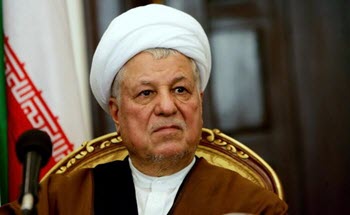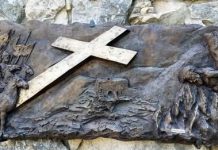Backgrounder: Rafsanjani’s Record on Key Issues as a Pillar of Iran’s Fundamentalist Regime
Monday, 09 January 2017 20:20
NCRI – Former Iranian President Ali-Akbar Hashemi Rafsanjani, who died on January 8, 2017, aged 82, was one of the two pillars and ‘key to the equilibrium’ of the Iranian regime.
Over the past 38 years, both under Khomeini and in later years, Rafsanjani played a critical role in suppression at home and export of terrorism abroad as well as in the quest to acquire nuclear weapons. Though portrayed by some Western media outlets as a “pragmatist” or “moderate,” during his long career he was associated with some of the regime’s most egregious actions, including mass-casualty terror attacks and the assassinations of exiled dissidents.
Rafsanjani was a stalwart of the Iranian regime and is considered as one of its founding fathers. He played an outsized political role in the life of the Islamic republic, serving as President from 1989-1997 (after serving as Speaker of Parliament and Deputy Commander of the Armed Forces), but also heading two of the regime’s most important institutions – the Assembly of Experts, an 88-member body of top clerics which nominates the Supreme Leader; and the Expediency Council, a body that advises the Supreme Leader.
“Rafsanjani, who had always been the regime’s number two, acted as its balancing factor and played a decisive role in its preservation. Now, the regime will lose its internal and external equilibrium,” opposition leader Maryam Rajavi said in a statement that also referred to the “approaching overthrow” of the clerical regime.
Suppression at home
 • Rafsanjani viciously called for the extermination of members of Iran’s main opposition group, the People’s Mojahedin Organization of Iran (PMOI or MEK). On October 3, 1981, the state-run Ettela’at daily wrote:
• Rafsanjani viciously called for the extermination of members of Iran’s main opposition group, the People’s Mojahedin Organization of Iran (PMOI or MEK). On October 3, 1981, the state-run Ettela’at daily wrote:
“Referring to the grouplets’ operations, Hashemi Rafsanjani, Speaker of the Islamic Parliament and Tehran’s acting Friday prayer leader, said in his sermon:
‘Divine law defines four sentences for them which must be carried out: 1 – kill them, 2 – hang them, 3 – cut off their arms and legs, 4 – banish them…
‘Had we caught and executed 200 of them right after the Revolution, they would not have multiplied so much. If we don’t deal decisively with [Mojahedin] armed grouplet and agents of America and the Soviet Union today, in three years we will have to execute thousands of them instead of one thousand now…”
• According to Khomeini’s former heir Hossein-Ali Montazeri, Khomeini sought counsel on his dangerous decisions from these just two individuals: Rafsanjani and current Supreme Leader Ali Khamenei. This included his decision to issue a fatwa ordering the massacre of some 30,000 political prisoners at the end of the Iran-Iraq war in the summer of 1988.
Terrorism abroad:
The assassination of Iranian dissidents abroad and the regime’s terror attacks skyrocketed during Rafsanjani’s tenure as President and as head of the Supreme National Security Council (SNSC), a body that oversees and authorizes the regime’s terrorist operations. The mullahs’ terror targets were not only Iranians.
• The Associated Press reported Rafsanjani’s remarks on May 5, 1989 as carried by Iran’s official state news agency IRNA: “If in retaliation for every Palestinian martyred in Palestine, they will kill and execute, not inside Palestine, five Americans or Britons or Frenchmen, the Israelis could not continue to do these wrongs… It is not hard to kill Americans or Frenchmen. It is a bit difficult to Kill [Israelis]. But there are so many [Americans and Frenchmen] everywhere in the world.”
 • In 2006, Rafsanjani was implicated by Argentinian investigators in one of the deadliest instances of Iranian terrorism abroad – a 1994 suicide truck bombing of the AMIA Jewish community center in Buenos Aires, in which 85 people were killed.
• In 2006, Rafsanjani was implicated by Argentinian investigators in one of the deadliest instances of Iranian terrorism abroad – a 1994 suicide truck bombing of the AMIA Jewish community center in Buenos Aires, in which 85 people were killed.
The investigators accused Iran of instructing its Lebanese proxy, Hezbollah, to carry out the bombing. They issued arrest warrants for Rafsanjani, seven other senior Iranians, and a Lebanese national, Hezbollah terrorist chief Imad Mughniyah.
 At Argentina’s request, Interpol then issued red notices – the organization’s equivalent of arrest warrants – for five of the Iranians and Mughniyah.
At Argentina’s request, Interpol then issued red notices – the organization’s equivalent of arrest warrants – for five of the Iranians and Mughniyah.
• The FBI established undeniable evidence that Tehran had masterminded the bombing of Khobar Towers in Saudi Arabia on June 25, 1996, resulting in the deaths of 19 American servicemen.
Here are some of the most significant killings of prominent dissidents abroad during Rafsanjani’s tenure:























